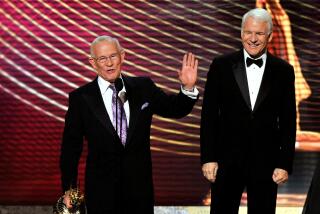Jarring look at an earlier entertainment era
- Share via
Seventy years ago, on Aug. 20, 1938, The Times published an editorial mourning the death of Thomas K. Heath, one of vaudeville’s biggest stars in what is now the largely vanished phenomenon of the minstrel show.
Today, the once sensationally popular minstrel shows, in which white actors (and sometimes blacks) mimicked the worst racial stereotypes, are largely viewed as ugly symbols of the past. Little survives in popular culture except for a few jarring clips from old movies, like one of the sketches in “Yankee Doodle Dandy.”
One of the most popular such acts was Heath and his partner Jim McIntyre, who performed in blackface for many years after they teamed up in 1874. I’d never heard of them and I wondered who they were.
But while researching Heath and McIntyre, I ran across another team of entertainers who were far more obscure: Bert Williams and George Walker. Instead of two white comedians pretending to be black, Williams and Walker were African American. And, according to The Times, they were from Los Angeles. These fellows sounded fairly interesting and worth investigating.
Although minstrels today may seem like nothing more than embarrassing relics, in their time they shared the stage with actors whose legacies are well known.
McIntyre and Heath, for example, signed the autograph book of young vaudeville performer Buster Keaton and wished him well in his career. In January 1902, they appeared at the Orpheum in Los Angeles along with a young “eccentric juggler” named W.C. Fields.
And the team was a sensation.
The Times said in 1898: “Last night’s audience laughed at these two until there was not a dry eye or a side without a pain in it upstairs or down; indeed, the audience did not simply laugh, it yelled and shrieked in its ecstasy of merriment and the curtain went down with the roar of its cachinations still echoing among the rafters.”
Minstrel shows emerged before the Civil War in skits that claimed to depict plantation life in the South, blending “mirth and melody.”
There was no scenery, merely a string of about 15 men in blackface arranged in a crescent across the stage. In the center was the middle man and at either end were two “end men,” whose jokes kept the performances lively.
“First would come the overture,” The Times said, “made up of popular airs.” The middle man would address one of the end men, saying: “ ‘How is Brother Bones this evening?’ Brother Bones would answer, ‘Scrumptious,’ or words to that effect.”
What followed was a mix of jokes, comic songs, pathetic ballads, dancing and sketches.
In the late 19th century, McIntyre and Heath -- and Williams and Walker -- performed many times in Los Angeles, almost always at the Orpheum, which at that time was on South Spring Street.
McIntyre and Heath’s most famous routine was “The Ham Tree,” a sketch so well known that the Times’ reviewers felt no need to describe it. In the act, the men would act out a series of misadventures that ensue after one talks the other into quitting his job at a livery stable so they can go on the road in a minstrel show.
Williams and Walker had a famous skit based on their song, “You Ain’t So Warm,” which meant “you are not so great,” Williams told The Times in an interview.
In May 1898, both teams appeared on the same Orpheum playbill: McIntyre and Heath, “the great Blackface Comedians,” and Williams and Walker, “the real Colored Comedians.”
Be warned: The racial references in the Times review from 1898 will set your teeth on edge. Here’s what we said: “Williams and Walker, the two darky Angelenos, are back from triumphs in foreign lands and eastern cities to the scene of their initial success and were given an ovation.
“They are as funny a pair of mokes as their race has ever given to the comedy sketch, and the cake walk which concludes their act, which comprises in addition to the two principals a pair of dusky damsels who are high-steppers, and a band master who twirls the baton with fine skill, is the very poetry of darky motion.
“As for McIntyre and Heath,” The Times said, “those who in other days have seen this pair of darky impersonators need be told but little.”
Unfortunately, The Times never interviewed McIntyre or Heath. But we did talk to Williams and Walker several times and I found some gems in the stories, such as this quote from Williams in 1898, the year before Scott Joplin published “The Maple Leaf Rag,” one of his most famous works:
“Ragtime has been overdone and the public is getting tired of it.”
Although McIntyre and Heath performed for many years in vaudeville, Williams and Walker did not survive nearly as long. George Walker died Jan. 6, 1911, in a New York sanitarium, having been ill for a year. The Times did not even report his death. According to the New York Times, he was buried in Lawrence, Kan. Born in 1873, he was 37 or 38.
Egbert Austin “Bert” Williams died in New York on March 5, 1922, at the age of 48, and his obituary appeared on the front page of The Times, headlined “Two races in tribute mourn passing of Bert Williams.” His father was a Danish envoy in Nassau, the Bahamas, and his mother was “part Spanish and part African,” The Times said. He had graduated from high school in San Pedro.
In the years that followed, Williams and Walker were remembered reverently. In November 1938, Flournoy E. Miller, another famous African American performer who was one of the writers of the hit musical “Shuffle Along,” looked back at the days of Williams and Walker and said there was a need for “clean old real Negro shows.”
McIntyre and Heath continued performing and on May 17, 1925, The Times ran a review of their farewell appearance at the Orpheum, which by then had moved to Broadway. They last appeared together in Philadelphia in 1934.
McIntyre died Aug. 18, 1937, at the age of 89. Heath died exactly one year later at the age of 85 without ever being told that his partner was dead. And with them an era died as well.
--
More to Read
The biggest entertainment stories
Get our big stories about Hollywood, film, television, music, arts, culture and more right in your inbox as soon as they publish.
You may occasionally receive promotional content from the Los Angeles Times.










